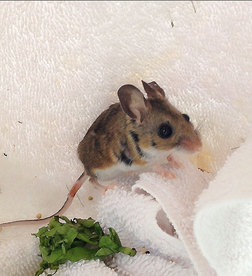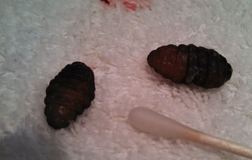WildCare's Wildlife Hospital treats nearly 4,000 ill, injured and orphaned wild animal patients from over 200 species every year. This is one patient's story.
 This Deer Mouse probably felt like she had been invaded by aliens when several bot fly larvae hatched and grew to massive proportions under her skin.
This Deer Mouse probably felt like she had been invaded by aliens when several bot fly larvae hatched and grew to massive proportions under her skin.
Like monsters out of a horror film, flies of the family Oestridae lay their eggs on live mammals. The eggs hatch, and the larvae burrow into the host's living flesh to grow to maturity.
Fortunately for this small native rodent, WildCare's Director of Animal Care, Melanie Piazza was on a run and happened to see the mouse cowering under a leaf. Melanie brought her to the Wildlife Hospital, where the massive disfiguring lumps on the mouse's body made diagnosis easy.
Bot fly cases are rare, but possibly due to the California drought, incidents of these and other parasitic infestations in our wildlife patients are on the rise.
In the world of parasitic flies, bot flies in particular inspire revulsion. The flies lay their eggs on the skin of a mammal, and the animal's body heat causes the eggs to hatch. The larvae then embed themselves in the animal's skin.
These larvae, called, nauseatingly enough, "warbles," mature under the skin of the host animal until they are old enough to extract themselves, fall to the ground and metamorphose into mature bot flies.
Horror films show humans being invaded by bot flies, and actually a neotropical species of the fly will occasionally use humans as hosts. We're lucky that the North American species prefer other mammals on which to lay their eggs!
Mammals like this unfortunate little Deer Mouse.
Once at the Wildlife Hospital, the mouse was given pain medications and started on a course of antibiotics. Then the warbles were gently extracted (we won't describe the process) and the cavernous wounds were cleaned first with a saline solution and then with diluted antiseptic.
The mouse was offered food, which she promptly ate, and was placed in a warm enclosure to rest and heal.
 Bot fly larvae excrete an antibacterial secretion that should prevent secondary infection, but an infection had nonetheless started in this mouse's shoulder that needed treatment. Over the course of the next couple of weeks, two different antibiotics were tried, one of which finally eliminated the infection.
Bot fly larvae excrete an antibacterial secretion that should prevent secondary infection, but an infection had nonetheless started in this mouse's shoulder that needed treatment. Over the course of the next couple of weeks, two different antibiotics were tried, one of which finally eliminated the infection.
This Deer Mouse may carry some scars from her experience with the "body snatchers," but she will have no lasting disability. She will be released very soon.
Scroll down to see video of her healthy and feeling good in her enclosure at WildCare!
Parasitic Infestations on the rise
WildCare RVT, Nat Smith who did the exam and warble extraction on this patient also noted that the mouse had a large number of mites and seed ticks (juvenile ticks) on her. He notes that WildCare Medical Staff has seen an increase in the number of patients with heavy parasite loads this year, probably in part because of the ongoing drought.
Drought causes animals to congregate around available water sources. This close proximity allows parasites to easily jump from animal to animal, increasing the number and variety of parasites carried by each individual.
Animals that struggle to find water are weakened, which makes their bodies less able to fight off infections. Many parasites are opportunistic and will colonize quickly if an animal can't properly eliminate them.
In addition, some parasites may benefit from the dry conditions with better breeding and hatching success.
Whatever the reason, Medical Staff may expect to see another bot fly patient in the near future.
WildCare is a 501(c)3 nonprofit organization supported almost entirely by private donations and individual memberships. Visit us online at wildcarebayarea.org.

